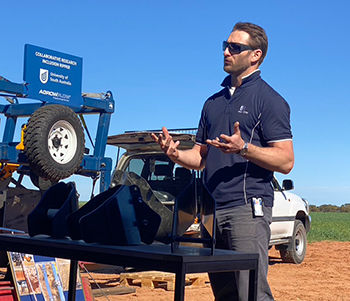Grain growers from across South Australia and western Victoria are set to tap into the higher grain production potential of their sandy soils through masterclasses in August and September.
Constrained by their limited capacity to hold moisture and nutrients, many sandy soils in the states’ low- and medium-rainfall zones produce less than half of their yield potential.
With new knowledge generated from a consortium of researchers supported by the Grains Research and Development Corporation (GRDC), growers can access new tools, techniques and know-how to get more out of their sandy soils through six half-day masterclasses.

Engineering experts will be on hand to discuss machinery selection and set up. Photo: GRDC
Dr Therese McBeath, Principal Research Scientist at CSIRO, is leading the research and says the masterclasses will help growers and advisers diagnose soil constraints and identify ways to increase production – including, through deep ripping and other tillage techniques.
“We’ve seen significant increases in yield and profit following deep ripping on sandy soil and growers are really interested in the technique,” says Dr McBeath.
“We want to share what we have learnt about which tillage technique best addresses the key constraints in sands so growers can assess when they should and should not conduct deep tillage.”
Each masterclass will be held at a trial site with a soil pit where participants will identify soil constraints with a soil specialist and inspect tillage responses in the paddock with agronomists. Engineering experts will also discuss how to select machinery for deep ripping and effective set up and operation.
“Lots of people are buying, or want to buy, machinery for deep tillage – we’ll discuss with growers how to figure out when investing is machinery is cost effective and have a dedicated session on determining profit and risk implications at farm scale,” says Dr McBeath.
For GRDC, investing grower levies into research to reduce the impact of soil constraints and identify the most cost-effective solutions helps solve a long-term problem.
“When we started this work in 2016, growers with sandy soils were finding that after harvest there was moisture left in the subsoil, and the roots of the crop were unable to access it,” said Dr Stephen Loss, GRDC Senior Regional Manager – South.
“It was obvious that something was constraining root growth at depth, but we weren’t sure what it was.
“This project has shown that while water repellency and soil acidity can restrict crop performance on sandy soils, compaction and high soil strength is common in most of those sandy soils in South Australia, Victoria and southern New South Wales. In most cases deep ripping is a cost-effective way to overcome and correct that.”
“The benefit may last at least two to three years before you have to come back and deep rip again.”
Covering the Eyre and Yorke Peninsulas, the upper South East and the mallee region, the free masterclasses will be held in partnership with local farming organisations AIR EP, Northern Sustainable Soils, MacKillop Farm Management Group, and Mallee Sustainable Farming.
Registration is required:
- Aug 30, 9am-1.30pm, Murlong, SA – Murlong masterclass
- Aug 31, 9am-1.30pm, Buckleboo, SA – Buckleboo masterclass
- Sep 1, 1pm-5.30pm, Bute, SA – Bute masterclass
- Sep 13, 1pm-5.30pm, Coomandook, SA – Coomandook masterclass
- Sep 15, 9am-1.30pm, Kooloonong, VIC – Kooloonong masterclass
- Sep 16, 9am-1.30 pm, Pinnaroo, SA – Pinnaroo masterclass
Other resources generated by the project include fact sheets and case studies that will be published on the GRDC website.
This project is a collaboration between the CSIRO, the University of South Australia, the SA Government Department of Primary Industries and Regions, Mallee Sustainable Farming Inc., Frontier Farming Systems, Trengove Consulting, AgGrow Agronomy, AIREP, and MacKillop Farm Management Group.

























































